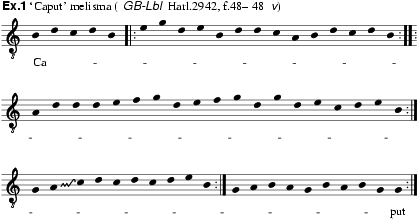
The melisma on the final word, ‘caput’, of the antiphon Venit ad Petrum (ex.1), found in the Maundy Thursday ritual of the Washing of the Feet (the mandatum ceremony) in the English Use of Salisbury and other liturgical uses (Bukofzer, 1950) and used as a cantus firmus in three surviving masses and a Marian motet. The earliest work based on the melisma, a four-voice mass ascribed in the Trent codices to Du Fay, has been shown to be a misattributed work by an anonymous English composer. This mass was clearly one of the most revered compositions of the 15th century. It has survived in no fewer than seven manuscripts, more sources than any other mass cycle written before the 1480s. It may also have been the most influential English mass from a time when insular cycles were providing a model for cyclic mass composition across Europe. Its four-voice texture, using a low contratenor and long-note tenor cantus firmus, with the structural melody stated twice in each movement in so-called double-cursus format, is found also in a large number of similarly constructed masses composed on the Continent beginning in the late 1440s (Wegman, 1990). Ockeghem's Missa ‘Caput’, probably among the earliest of these, is based directly on the tenor of the English mass, but transposed down an octave and placed in the lowest voice. Ockeghem adopted its complete rhythmic profile and set out the melody twice in every movement except the Kyrie, where it is heard just once.

The Kyrie of the English mass follows the pattern of all English festal masses of the time in setting a lengthy prosula text. For that reason, as in the case of many English cycles of the period, it was sometimes omitted in continental copies of the mass. It would appear that Ockeghem based his ‘Caput’ Mass on such a decapitated version of his English antecedent (Strohm). Obrecht's mass similarly follows the layout of the English cycle in all movements but the Kyrie, where its procedure follows that of Ockeghem's. In contrast to the other two, though, the melody is moved from voice to voice in successive movements. This mass is clearly much later than the anonymous and Ockeghem cycles, and probably dates from the late 1480s (Wegman, 1994). The idea of setting sacred works on the ‘Caput’ melody was clearly still alive in England by the end of the 15th century: a Salve regina by Richard Hygons entered into the Eton Choirbook around 1500 is based on the melisma (Harrison), and the ‘songge called Caput of iiij partys’ copied at St Margaret's, Westminster, in 1480–82 may have been a new mass, or perhaps a very late copy of the cycle with which the ‘Caput’ tradition began (Kisby).
M. Bukofzer: ‘Caput: a Liturgico-Musical Study’, Studies in Medieval & Renaissance Music (New York, 1950), 217–310
M. Bukofzer: ‘Caput redivivum: a New Source for Dufay's Missa Caput’, JAMS, iv ( 1951), 97–110
F.Ll. Harrison: ‘An English “Caput”’, ML, xxxiii (1952), 203–14
A.E. Planchart, ed.: Missae Caput, Collegium musicum, v (New Haven, CT, 1964)
M. and I. Bent: ‘Dufay, Dunstable, Plummer: a New Source’, JAMS, xxii (1969), 394–424
T. Walker: ‘A Severed Head: Notes on a Lost English Caput Mass’, Abstracts of Papers, AMS XXXV: St Louis 1969, 14–15
A.E. Planchart: ‘Guillaume Dufay’s Masses: Notes and Revisions’, MQ, lviii (1972), 1–23
R. Strohm: ‘Quellenkritische Untersuchungen an der Missa “Caput”’, Datierung und Filiation von Musikhandschriften der Josquin-Zeit: Wolfenbüttel 1980, 155–65
R.C. Wegman: ‘Petrus de Domarto's Missa Spiritus almus and the Early History of the Four-Voice Mass in the Fifteenth Century’, EMH, x (1990), 235–303
R.C. Wegman: Born for the Muses: the Life and Masses of Jacob Obrecht (Oxford, 1994)
F. Kisby: ‘Music and Musicians of Early Tudor Westminster’, EMc, xxiii (1995), 223–40
ANDREW KIRKMAN